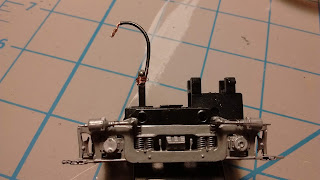The TP&W owned 3 EMD GP35s, numbered 900-902 and built in November 1965. These were the last TP&W locomotives delivered in the olive green and yellow paint scheme, and they lacked the diamond-shaped red and yellow TP&W herald that was applied to previous locomotives. ALCo RS-2s 200, 201, and 203 were traded in to EMD and their trucks were reused on the GP35s. All 3 of these locomotives remained in their original paint throughout the 1970s. The 902 appears to have been the first GP35 repainted in red-orange and white circa 1980. The 902 became Santa Fe 3464 in 1984 and was later renumbered to 2963 after being rebuilt with dynamic brakes and EMD trucks. The 2963 became BNSF 2645 and has been rebuilt again as a GP39-3.
Links to prototype photos:
TP&W 902 in 1977
TP&W 902 in 1980
ATSF 3464 in 1984
BNSF 2645 in 2013
BNSF 2645 in 2014
The Model
I acquired my green Athearn Ready-to-Roll TP&W 902 in 2005. I painted the trucks silver to better match the prototype. The prototype's yellow stripes and lettering rapidly faded to a cream color similar to that used on the model. The font used on the model for the cab numbers and "Toledo Peoria & Western" lettering has never looked quite right to me, but it's at least close. My model 902 got a lot of mileage on the old Illini Railroad Club layout while I was college but has been mostly in storage since 2008.
My 902 needed a bit of a tune-up before I could put it in service on the new layout. All of the axle gears had cracked and needed to be replaced.
 |
| Cracked axle gear. |
When I removed the locomotive shell, I found something I had completely forgotten about. The wire from the front truck broke off at some point. Lacking a soldering iron and soldering skills in those days, I simply stripped more insulation from the wire, drilled a new hole near the old solder joint, threaded the wire through it, and wrapped the wire around the metal tab on the truck frame. Not pretty, but it seemed to work ok.
 |
| No-soldering truck repair |
Repairs complete, the model 902 is ready for duty on the new layout.



No comments:
Post a Comment